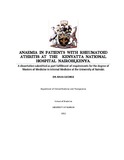| dc.contributor.author | Muia, George | |
| dc.date.accessioned | 2013-02-12T14:45:17Z | |
| dc.date.available | 2013-02-12T14:45:17Z | |
| dc.date.issued | 2012 | |
| dc.identifier.uri | http://erepository.uonbi.ac.ke:8080/xmlui/handle/11295/8852 | |
| dc.description.abstract | Rheumatoid arthritis {RA} is a chronic inflammatory auto-immune disease which primarily affects the joints. Anemia is the commonest extra-articular manifestation of RA. Anemia is an independent predictor of morbidity and mortality in the population. When RA is complicated by anemia it is associated withmore severe disease and significant reduction in the quality of life in the affected patient.
Objectives of the study: To determine the characteristics and the prevalence of anemia in patients with RA at the Kenyatta National Hospital {KNH} and to correlate the anemia with the disease activity using the modified disease activity score 28.
Study design: A cross sectional descriptive study.
Study setting: The study was conducted on patients with RA attending the Rheumatology outpatient clinic (ROPe) at {KNH}.
Methods: Patients presenting to the ROPC were screened and those who met the inclusion criteria were recruited to the study. The study period was 6 months from September 2011 to March 2012. Consecutive sampling technique was applied until the desired sample size was achieved. A targeted history followed by physical examination on all recruited patients. The patients' disease activity using the MDAS28 score was recorded.
The patients' full haemogram was measured using the coulter counter model S plus IV and the peripheral blood picture was reported by a hematologist. The ferritin was measured using the latex enhanced turbidimetric assay method. Patients' records/files were used to determine the type of drugs and the span of time the patient has been on treatment.
Data management
All the data was collected using a study proforma. Data and statistical analysis was done using the statistical package for social science (SPSS) version 17. Descriptive statistics such as frequency, proportions, mean, variance and standard deviation wf'!re used in results
presentation.
The anemia was then correlated with the. MDAS28 using the Pearsons correlation coefficients. A P value less than or equal to 0.05 was considered statistically significant. Precision was indicated by 95% confidence interval limits. The results were presented as pie charts, graphs and tables.
RESULTS
Ninety seven eligible patients were enrolled into the study in the six months period between September 2011 and March 2012.There were 84 (86.6%) females and 13 (13.4%) males giving a male to female ratio of 1:6.8. The mean age of the study population was 50 years with age range of 18-88 years. Seventy nine percent of the patients had the clinical features of RA for more than 1 year before presentation while 69% of the study population had the diagnosis made in the last 5 years. The commonest medications used were Methotrexate seen in 80% (74 patients) of the population and NSAIDS use was seen in 72% (67 patients).
The mean hemoglobin was 12.4 g/dl with a range of 3-15.7g/dl. While 33%. (n=32) of the patients had high disease activity and 58.8% (n=57) had moderate disease score. The prevalence of anemia in the study population was 33% with ACD responsible for 75% of the cases of anemia while IDA was seen in 25% of the cases.
Anemia was seen among the patients with high and moderate disease activity scores. None of the patients on remission and low disease scores had anemia. Anemia was also found to be independently related to the disease activity and the patient's gender with males being the most affected. The use of DMARDS was found to confer protection to anemia with a (P= 0.012). The study did not demonstrate any significant association between NSAID or steroid use and IDA.
CONCLUSION
There is still a high burden of anemia in RA patients although it is lower compared to studies done elsewhere. Anemia correlates very well with the disease activity. Anemia of chronic disease being the commonest type. The initiation of DMARDs was associated with reduction of anemia among the patients. Men form a small percentage of patients with RA locally but to present with severe anemia. | en_US |
| dc.language.iso | en_US | en_US |
| dc.publisher | University of Nairobi, Kenya | en_US |
| dc.title | Anaemia in patients with rheumatoid athritis at the Kenyatta National Hospital, Nairobi, Kenya | en_US |
| dc.title.alternative | Thesis (M.Med.) | en_US |
| dc.type | Thesis | en_US |

